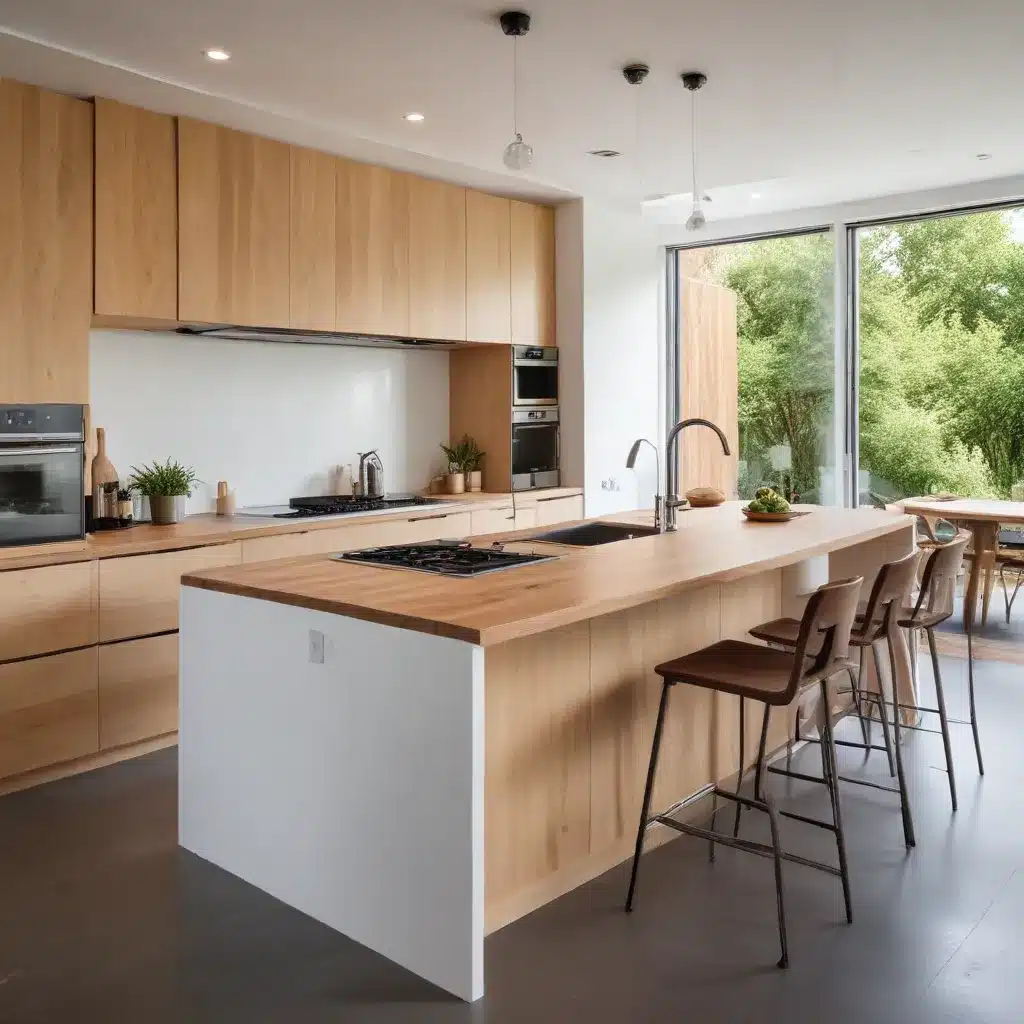
Sustainable Kitchen Design: Reducing Environmental Impact
As the demand for eco-friendly living continues to grow, homeowners are increasingly seeking ways to minimize their environmental footprint when renovating their kitchens. Sustainable kitchen design offers a holistic approach that goes beyond mere aesthetics, integrating sustainable materials, energy-efficient appliances, and water-conscious strategies to create beautiful, functional, and planet-friendly spaces.
Eco-friendly Materials
At the heart of sustainable kitchen design lies the careful selection of eco-friendly materials. Homeowners can opt for cabinetry made from FSC-certified wood or recycled chipboard, which repurposes wood waste and reduces the need for virgin timber. Formaldehyde-free composite woods and solid wood alternatives further improve indoor air quality by eliminating harmful off-gassing.
For countertops, recycled glass and bamboo offer stunning, durable, and environmentally-friendly options. These materials not only reduce the environmental impact of production but also contribute to a kitchen’s overall visual appeal. Other sustainable countertop choices include recycled paper or concrete mixed with natural materials, which minimize the use of fossil fuels during manufacturing.
Energy-Efficient Appliances
Upgrading to Energy Star-certified appliances is a crucial step in creating a sustainable kitchen. These high-efficiency models consume less electricity, translating into lower utility bills and a reduced carbon footprint. From induction cooktops that use magnetic energy to heat pots and pans, to smart refrigerators that monitor energy usage, eco-friendly appliances offer a wide range of features that cater to both environmental and financial considerations.
Additionally, integrating smart home technology can further enhance the sustainability of a kitchen. Smart water taps, for instance, help reduce water consumption by controlling flow more precisely. Similarly, energy-monitoring devices allow homeowners to track and manage their kitchen’s energy use, empowering them to make informed decisions about their consumption habits.
Water Conservation Strategies
Water conservation is another key aspect of sustainable kitchen design. Installing low-flow faucets and water-efficient dishwashers can significantly reduce a kitchen’s water usage without compromising performance or user experience. Homeowners can also consider adding a water filtration system, which eliminates the need for bottled water and reduces plastic waste.
In some cases, rainwater harvesting systems can be incorporated into the kitchen design, allowing homeowners to collect and reuse rainwater for tasks like irrigation or toilet flushing. This approach not only conserves potable water but also helps to alleviate the strain on municipal water supplies.
Reducing Waste in the Kitchen
Sustainable kitchen design also encompasses strategies to minimize waste, both in terms of materials and food.
Composting and Recycling
Establishing a composting system for kitchen scraps and food waste can dramatically reduce the amount of organic matter ending up in landfills. By diverting these materials to a compost bin, homeowners can create nutrient-rich soil for their gardens or houseplants, further enhancing the eco-friendly nature of their kitchen.
Implementing an effective recycling system is another essential component of sustainable kitchen design. Providing clearly labeled bins for materials like glass, plastic, and paper encourages household members to sort their waste properly, ensuring that recyclable items are diverted from landfills.
Minimizing Single-Use Plastics
One of the most significant ways to reduce waste in the kitchen is to eliminate or minimize the use of single-use plastics. This includes items such as disposable utensils, straws, and food containers. Homeowners can instead opt for reusable alternatives made from materials like bamboo, stainless steel, or glass, which are not only more eco-friendly but also often more durable and aesthetically pleasing.
Food Waste Management
Addressing food waste is another crucial aspect of sustainable kitchen design. Homeowners can implement strategies like meal planning, proper food storage, and utilizing leftovers to reduce the amount of edible food that ends up in the trash. Additionally, investing in energy-efficient appliances like smart refrigerators can help minimize food spoilage by maintaining optimal temperatures and providing better visibility of stored items.
Ergonomic Design Considerations
Sustainable kitchen design goes beyond environmental considerations, also encompassing ergonomic design that enhances the usability and accessibility of the space.
Accessibility and Universal Design
Incorporating universal design principles ensures that the kitchen is functional and comfortable for users of all ages and abilities. This may include features such as adjustable-height countertops, pull-out shelves, and lever-style faucets, which make the space more inclusive and user-friendly.
Workflow Optimization
Thoughtful kitchen layout and workflow optimization can also contribute to the overall sustainability of the space. By arranging the work triangle (sink, stove, and refrigerator) efficiently, homeowners can reduce the amount of time and effort required to complete daily tasks, ultimately saving energy and resources.
Lighting and Ventilation
Proper lighting and ventilation design are essential for creating a healthy, comfortable, and energy-efficient kitchen environment. Task lighting over key work areas, natural lighting from windows or skylights, and high-performance ventilation systems all help to reduce energy consumption while enhancing the overall user experience.
Integrating Renewable Energy
For homeowners seeking to take their sustainable kitchen design to the next level, the integration of renewable energy sources can be a transformative step.
Solar-Powered Kitchens
Solar-powered kitchens leverage the power of the sun to generate electricity for appliances, lighting, and other electrical needs. By installing photovoltaic panels, homeowners can significantly reduce their reliance on the grid, lowering their environmental impact and utility bills.
Geothermal Heating and Cooling
Another innovative approach is the incorporation of geothermal heating and cooling systems. These systems use the stable temperatures found just below the Earth’s surface to provide efficient and eco-friendly climate control for the kitchen and the entire home.
Wind-Powered Appliances
While less common, wind-powered kitchen appliances are also a sustainable option for homeowners living in areas with consistent wind patterns. These specialized appliances harness the power of the wind to generate the electricity needed to power kitchen equipment, further reducing the carbon footprint of the space.
By embracing these sustainable design principles, homeowners can transform their kitchens into eco-friendly havens that not only minimize their environmental impact but also enhance their overall quality of life. As the demand for sustainable living continues to grow, the team at Reluctant Renovator is committed to guiding homeowners through the process of creating beautiful, functional, and planet-friendly kitchens.



